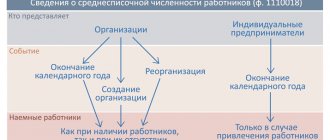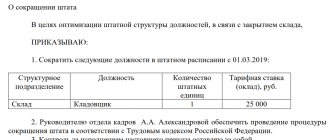https://youtu.be/32t__rxC3N0
Indication in form 4-FSS of the average number of employees in 2019-2020: what to pay attention to
How to calculate the average number of employees for 4-FSS: stages
Stage 1: calculating the average headcount per day (an example of calculating the average headcount for Social Insurance Fund-4)
Stage 2: calculating the average number of part-time employees
Stage 3: calculation of the average headcount per month
Stage 4: calculation of the average number of part-time employees per month
Stage 5: calculation of the average number of employees for the quarter
Results
Accountant's Directory
Example.
The organization was re-established and began operating in March.
The average number of employees in March was 720 people. Consequently, the average number of employees for the first quarter for this organization was 240 people (720: 3). 7. If the organization operated for less than a full year
(seasonal work or was created after January), then the average number of employees for the year is determined by summing the average number of employees for all months of the organization’s operation and dividing the resulting amount by 12.
In accordance with paragraph 81 of the Instructions, the average number of employees per month is calculated
by summing the payroll number of employees for each calendar day of the month, that is, from the 1st to the 30th or 31st (for February - to the 28th or 29th), including holidays (non-working days) and weekends, and dividing the resulting amount by the number of calendar days of the month.
Average headcount calculated by 4-FSS (nuances)
- employees working part-time;
- employees on maternity leave or parental leave, with the exception of those working from home or part-time while maintaining the right to benefits;
- employees who are on unpaid study leave;
- part-time employees;
- individuals performing work under civil contracts;
- owners of the organization who do not receive wages;
- lawyers;
- military personnel when performing their military service duties (clause 78 of order No. 772).
- in January - 2 people (272 hours / 8 working hours per day / 17 working days per month);
- in February - 2 people (304 / 8 / 19);
- in March - 2 people (320 / 8 / 20);
- in April - 2 people (336 hours / 8 working hours per day / 21 working days per month);
- in May - 2 people (320 / 8 / 20);
- in June - 2 people (320 / 8 / 20);
- in July - 2 people (352 / 8 / 22);
- in August - 2 people (368 / 8 / 23);
- in September - 2 people (320 / 8 / 20);
- in October - 2 people (368 / 8 / 23);
- in November - 2 people (336 / 8 / 21);
- in December - 2 people (336 / 8 / 21).
https://youtu.be/PvP_IuZjZpI
Stage 2: calculating the average number of part-time employees
When calculating the average number of part-time employees, you need to keep in mind that their working days during the period when they are on sick leave or on vacation should be included in working hours in the number of hours worked on the previous day.
In order to calculate the indicator in question, you need:
1. Calculate the total number of hours that part-time professionals worked during the month.
2. Multiply the duration of a working day in a company in hours by the number of working days in a month.
3. Divide the result of step 1 by the result of step 2.
Example (continued):
Let's continue the calculations to generate reports to the Social Insurance Fund for the 4th quarter of the conditional reporting year. Let's agree that our company employs 4 part-time specialists, each of whom comes to work for 4 hours from Monday to Friday.
It turns out that each of the specialists will work part-time:
- in January - 68 hours (4 × 17 working days from Monday to Friday);
- in February - 76 hours (4 × 19);
- in March - 80 hours (4 × 20);
- in April - 84 hours (4 hours × 21 working days from Monday to Friday);
- in May - 80 hours;
- in June - 80 hours;
- in July - 88 hours;
- in August - 92 hours;
- in September - 80 hours;
- in October - 92 hours;
- in November - 84 hours;
- in December - 84 hours.
In total, all part-time employees will work:
- in January - 272 hours (68 hours × 4 people);
- in February - 304 hours;
- in March - 320 hours;
- in April - 336 hours;
- in May - 320 hours;
- in June - 320 hours;
- in July - 352 hours;
- in August - 368 hours;
- in September - 320 hours;
- in October - 368 hours;
- in November - 336 hours;
- in December - 336 hours.
Calculation of the average number of employees in a newly created organization for 4fss
For example, if an organization was created on August 13 (this is the third quarter), then the first reports to the Social Insurance Fund must be submitted 9 months in advance by October 15. Please note: despite the fact that the organization was created on August 13, reporting is submitted for 9 months: from January 1 to June 30.
The procedure for filling out these fields was approved by order of the Social Insurance Fund dated June 7, 2017 No. 275. The average headcount is reflected for the reporting period, that is, from the beginning of the year. Previously, this indicator was filled out at the reporting date. The other two indicators (number of disabled people and hazardous workers) are still filled in as of the reporting date.
We recommend reading: Termination of a contract by agreement of the parties if they do not allow the maternity leave to be extended
What number is included in 4-FSS
On the title page of the 4-FSS in 2020, indicate (clause 5.15 of the Procedure for filling out the 4-FSS):
- in the “Average number of employees” field – the average number of employees for the 1st quarter of 2020, calculated in the usual manner;
- in the field “Number of working disabled people” – the list number of disabled people as of 03/31/2019;
- in the field “Number of employees engaged in work with harmful and (or) hazardous production factors” - the list number of employees engaged in hazardous work as of March 31, 2019.
Let us give an example of calculating the average number of employees for 4-FSS in 2019.
Monthly indicators of the number of employees of the enterprise:
- for January is equal to twelve;
- for February it is equal to eleven;
- for March is thirteen.
The calculation indicator for the 1st quarter of 2020 of the average headcount for FSS-4 in this example will be equal to twelve ((12 + 11 + 13) / 3 = 12). It is this indicator that is to be reflected in the corresponding line of the 4-FSS calculation.
Average number of employees calculated by 4-FSS in 2020: examples
- those who actually showed up for work, regardless of whether they worked or not due to downtime;
- those who worked on business trips;
- disabled people who did not show up for work;
- performing state or public duties outside the place of work;
- being tested;
- vacationers (including at their own expense);
- truants;
- persons under investigation, etc.
The calculation of the number of employees in question is carried out using information from the payroll records for each day. The daily indicator must be equal to the corresponding indicator reflected in the time sheet maintained by the enterprise.
Average headcount 2018: goals and calculation procedure
The average number of employees is considered to be the sum of the number of employees for a certain period. The procedure for its calculation is established by statistical authorities (see instructions approved by Rosstat order No. 772 of November 22, 2017). By summing the average number of employees with the number of employees working under external part-time jobs and employment contracts, we obtain the average number - an indicator based on which the employer’s right to:
- application of a simplified taxation system (Article 346.12 of the Tax Code of the Russian Federation);
- benefits for small enterprises (Law No. 209-FZ of July 24, 2007);
- submission of statistical reporting using a simplified system (Rosstat order No. 335 dated December 31, 2009);
- VAT benefits (Article 149 of the Tax Code of the Russian Federation);
- reduction of land tax (Article 395 of the Tax Code of the Russian Federation) and property tax (Article 381 of the Tax Code of the Russian Federation).
To ensure that information about the average number of employees is reliable, take into account all employees actually employed by the company: permanent, temporary and seasonal. If the owners work at the enterprise and receive a salary, include them in the list as well. The number of employees is taken into account in full, regardless of the amount of time actually worked, in particular:
- regular staff;
- those on sick leave, on vacation or on a business trip;
- those working at home or on reduced working hours as required by law (disabled people, minors, “harmful” workers);
- hired under a fixed-term employment contract;
- temporarily sent from other organizations, if their earnings at their main place of work are not retained for this period;
- those who have taken study leave and combine work with study, as well as those sent to advanced training courses;
- absent due to downtime;
- probationers and trainees.
An employee working part-time or part-time is counted in proportion to the time worked. This rule does not apply to those for whom such a work schedule is established by the sole decision of management. Women on maternity leave and employees who have taken maternity or adoption leave are not included in the average headcount. Also, employees who took leave at their own expense to enroll in educational institutions or study are not taken into account.
An example of filling out a certificate of average headcount
Advice from the editor. Do not confuse the average number of employees with the payroll - we are talking about two different indicators. Some employees, for example, women on maternity leave, are included in the payroll, but not in the average payroll. But with employees working under special contracts with government agencies to attract additional labor, the situation is exactly the opposite. But there are also similarities. Are external part-time workers included in the average headcount? No, just like on the payroll. Read more about the rules for calculating different types of statistical indicators in the Personnel System materials.
How to calculate the average number of employees for 4-FSS
In accordance with Order of the Federal Social Insurance Fund of the Russian Federation No. 381, the updated form 4-FSS began to be effective in the first quarter of this year. According to clause 5.15 of this Order, the average headcount is calculated in accordance with the forms approved by Rosstat.
Rosstat instructions (Order N 498) state that the average payroll number for 1 month includes the payroll number for each day (30 or 31, and in February - 28 or 29), divided by 12. Both weekends and holidays are taken into account.
How to calculate the number of employees for 4-FSS in 2020
This indicator is calculated as of the end of the reporting period (clause 5.15 of Order No. 381). There is no need to calculate the NAV as of January 1 of the year in which the form is submitted. For example, when filling out data for Q2. 2020 number value is calculated as of 06/30/18; for 3 sq. – as of 09.30.18, etc.
The procedure is given in Rosstat Order No. 772 dated November 22, 2017 (clause 75-79.10). In accordance with the specified regulatory document, when calculating the average number of employees, list data is used. Daily indicators are summed up and divided by the number of days (calendar). Personnel orders serve as confirmation. Which categories of personnel are included in the payroll are determined in clauses 77-78.
Note! Women on maternity leave, children's leave, persons in training, external part-time workers according to clauses 78, 79.1 are not included in the SC. Part-time specialists are counted in proportion to the time worked (clause 79.3).
Average headcount
Calculation:
- The total number of man-hours worked by these employees is calculated by dividing the total number of man-hours worked in the reporting month by the length of the working day, based on the length of the working week, for example:
- Then the average number of part-time workers for the reporting month is determined in terms of full-time employment by dividing the person-days worked by the number of calendar working days in the reporting month. (At the same time, for days of illness, vacation, absences (falling on working days according to the calendar), the number of man-hours worked conditionally includes hours on the previous working day (in contrast to the methodology adopted for recording the number of man-hours worked)).
Formula for calculating the average number of employees per year
How to calculate the average number of employees for the year if they work for half the rate? First, you should determine the number of employees in a month by dividing the sum of the payroll for the entire period, including weekends and holidays, by the total number of working days.
The LLC has a 40-hour, 5-day week. From January to November, 15 people worked; in December, four people were laid off. For September and October, part-time contracts were concluded with 5 employees, under which they worked 4 hours daily. During the year, the company employed 3 part-time workers who are registered with another company. How to calculate the average number of employees for the year? Formula:
Deadlines for submitting form 4-FSS
Companies submit Form 4-FSS to the branch of the FSS of the Russian Federation at the place of their registration within the following deadlines:
- no later than the 25th day of the month following the reporting period, if reporting is sent electronically;
- no later than the 20th day of the month following the reporting period, if it is submitted in paper form.
Thus, you must submit the calculation in form 4-FSS for 2020 no later than:
- January 20, 2020, if the policyholder reports on paper;
- January 27, 2020 (including weekends), if the policyholder submits reports electronically.
Let us remind you that policyholders whose average number of employees exceeds 25 people send Form 4-FSS to social insurance in electronic form. Policyholders with this indicator of 25 people or less can submit the form on paper.











